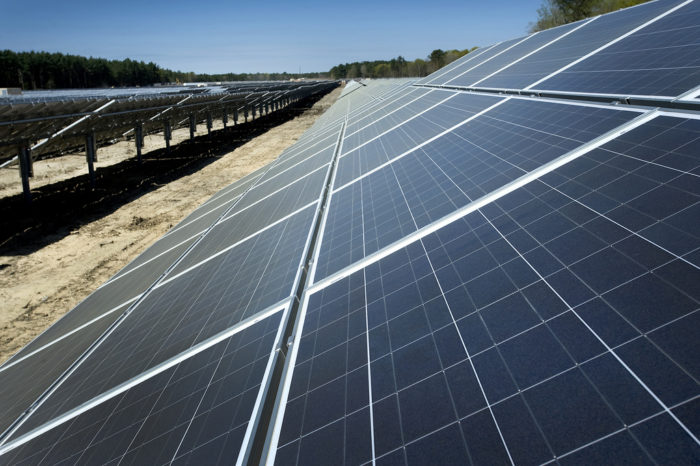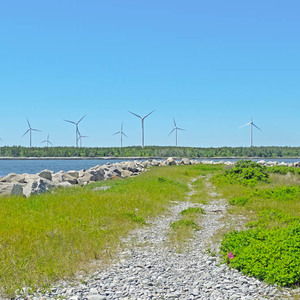
Image Credit: Brookhaven National Lab via Flickr
In an energy auction in Mexico last fall, the Italian energy conglomerate ENEL was reported to have submitted the lowest ever bid for supplying solar electricity — just $17.70 per megawatt hour, or 1.77 cents per kilowatt hour. It turns out the bid actually was for wind-generated power, not solar, but the initial reporting error didn’t change the underlying fact: the cost of both wind and solar electricity is sinking fast.
In reporting on the energy auctions, Electrek said the record low bid was among four from ENEL totaling 682 megawatts of electricity. The price was slightly lower than the 1.79-cents per kWh recorded in Saudi Arabia last October, leading the Electrek writer to predict prices of 1 cent per kWh by next year, if not sooner.
In Colorado, Xcel Energy received bids from potential suppliers of wind and solar power that will allow it to build and operate new plants for less than it would cost to keep its coal-burning power plants on line, according to an op-ed piece published in The New York Times this week.
Even Saudi Arabia, the biggest oil producer in the world, is diving into renewables with immediate plans for a $300 million solar farm capable of powering as many as 200,000 homes. A much bigger campaign to develop renewables is in the making.
Mexico’s fall power auction
The initial press release from the Centro Nacional de Control de Energía last November cited the price for the record low bid, but not the source of power. That led to the original reporting mistake. But the details of the auction showed bid prices on more than a dozen wind and solar projects all hovering in the 2 cents-per-kWh range. While ENEL’S wind bids were the lowest of the lot, the average bid price on the 2.3 gigawatt total from both wind and solar was 2.05 cents per kWh.
The projects are due to come on line in 2020.
Worldwide, Electrek reported, solar prices have fallen from a record of 8.3 cents per kWh in 2013, to 5.84 cents in 2014, 4.97 cents in 2015, to a low of 2.42 cents per kWh in 2016. The bids were recorded in the U.S., the United Arab Emirates, and Saudi Arabia.
Electrek noted at the time: “When the bids of 2.42¢/kWh hit last summer in 2016, much of the world suggested this was a bottom that was unique and couldn’t be passed without financial loss by the owners. When Saudi Arabia hit 1.79¢/kWh just a few weeks back — the narrative was that these prices were impossible elsewhere in the world because nowhere else in the world has Saudi Arabian oil money, sunlight, and control of all levels of government.”
Then came Mexico, leading Electrek writer John Fitzgerald Weaver to predict a solar project would cross the 1-cent line in 2019.
Strong interest in Saudi Arabia
The Saudis are the world’s largest exporter of oil, but by the end of the year the government will invest as much as $7 billion to develop solar and wind energy, The New York Times said. Renewables currently make up a minuscule amount of the energy used in the country, but the government officials hope solar and wind could make up 10% of the country’s energy mix by 2024.
Last June the country burned an average of 680,000 barrels of oil per day to run the air conditioners that make its climate habitable. But Saudi Arabia has plenty of oil, so why would it care about developing solar and wind?
Any oil that it burns at home is oil it can’t sell abroad, and that would have amounted to some $47 million a day last summer. So renewable sources of energy is one way of making the government’s bottom line look better. Developing a robust renewables industry also would help the government create new jobs for young people in an economic sector that essentially doesn’t exist now.
The solar project announced this week will be built in Sakaka, in the northern part of the country, at a wholesale price of between 2 cents and 3 cents per kWh, The Times said. That’s below the cost of electricity generated by fossil-fuel power stations.
In Colorado, coal is on the ropes
In Colorado, Xcel Energy has proposed closing two of its coal-fired power plants and replacing them with a mix of solar, wind, and natural gas, according to The Denver Post. At a public hearing last month, some speakers suggested that projected savings look so good that it makes sense for the utility to close all of its Colorado coal plants.
Last year, the utility said it would need 450 megawatts of additional power and solicited bids from potential providers. The median price for wind-only bids was 1.8 cents a kWh; the median price for solar was 2.95 cents. Those prices are very low, but The Post said the most surprising thing was that wind with battery storage was now cheaper than coal power generation, and solar plus storage was cheaper than about 75% of Colorado’s coal generation.
The median price for solar with storage was 3.6 cents per kWh, and wind with storage was 2.1 cents per kWh.
“As far as we know, these are the lowest renewables plus storage bids in the U.S. to date,” Carbon Tracker senior utilities and power analyst Matt Gray told the newspaper then. “The previously lowest known solar plus storage bid price was $45/MWh [4.5 cents per kWh] in Arizona in May 2017.”
Xcel had agreed last year to close the two coal plants as long as the move would save ratepayers money. Supporters said savings could reach $175 million — but that was before the “shockingly low” bids for renewable energy were reported last month.
Critics of the plan say it’s foolhardy to close the two coal plants in Pueblo because they could operate for many more years. Renewable energy bids, however, have been so low that advocates think that a complete transition away from coal has more promise.
Anita Seitz, a Westminster City Council member who testified at last month’s hearing, put it this way, according to The Post: “We feel the proposal to close old and inefficient coal plants more quickly and expand renewables in Colorado just makes sense. Shifting from coal to renewable energy creates jobs, saves money on everyone’s electric bills and helps clean up our air.”
The The New York Times op-ed piece notes that low bids received by Xcel benefit from federal subsidies that eventually will be phased out. But even when they’re gone, wind and utility-scale solar projects will still be competitive with fossil-fuel plants in much of the country. Xcel Energy expects more than half of the electricity it sells in its eight-state service area will come from renewable sources by the mid 2020s.
Nationally, the U.S. Energy Information Administration projected this week that renewable energy would more than double between 2017 and 2050 with an average annual growth rate of 2.8%, Utility Dive said.
Weekly Newsletter
Get building science and energy efficiency advice, plus special offers, in your inbox.















0 Comments
Log in or create an account to post a comment.
Sign up Log in